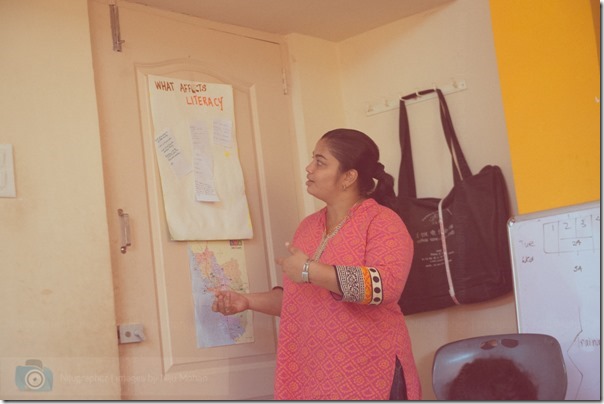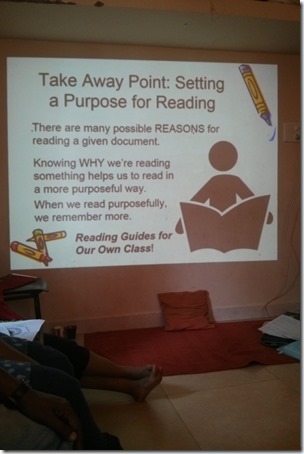Written by Dr. Nandita deSouza
Serendipity happens as regular as clockwork in my life. A remark made in passing by Sujata at one of our meetings, caught my attention ‘We are having a 3 day training for our Bookworm study group next week’. I seized this information with both ears and demanded to be included, together with my colleague Surabhi. Sujata, always ready to share love and learning, graciously accepted my ‘offer’!
Only those who spend time in classrooms in schools in Goa will understand how hard it is to ‘teach’ children to read and write English. Faced with multiple languages, lack of exposure to English, crowded classrooms, the burden of ‘covering the portion’, complicated texts, students from diverse backgrounds and a host of other challenges, language teachers can feel lost in this choppy sea of education, clinging to their fragile rafts of ‘teaching methods and modules’ as they move towards destination Literacy. But whoa, what a journey these 3 days have been been. I have learnt, read and understood more about literacy, than in all the years I have been struggling to stay afloat.
The course started even before we officially met, as every participant was expected to complete a preparatory reading. On Day 1 (and every other day), the morning started with affirmations, a soul-uplifting time that set the tone for the day. We were introduced to the concept of L3 – how language is strongly connected to literacy and is supported by literature. Language is socially constructed and is not acquired through vocabulary words and a set of grammar rules. It has different functions and forms, with every dialect having its unique richness. The Standard English taught in schools through rules and rote, negates the varied language and cultural experiences of students and often makes them feel isolated and inferior. From language, we discussed literacy and what it means. Through group work, we looked at what affects literacy, spending time talking about socio-cultural influences, economic and political forces, pedagogical approaches, parental aspirations and other complex dimensions. The moving story ‘The Winter Oak’ by Yuri Nagibin illuminated the day with its powerful message of the transformation that occurs when we look at the world through the eyes of a child.
On Day 2, after our heartening affirmations, we listened to a passage from Italo Calvini’s book “If On A Winter’s Night A Traveller” about ..…. well, any words I use will not do justice to its worth, but I will stumble and say—- about what it means to READ A BOOK. The participants broke up into smaller groups and talked about books – what we felt about them, the ones we loved or hated, which books captured our imagination, which ones we pretended to read and understand and so on. It was a time for shared remembrance, laughter and delight. Through our discussions, we explored the concept of our personal perspectives. Texts are never neutral and we engage with them differently.
A quick tour through the history of reading in the Western world was next on the agenda. The rationale and structures of Look and Say sight words, phonics instruction and the whole language approach were presented through representative texts. We were introduced to the salient features of the theories proposed by luminaries in the field of literacy research such as Jeanne Chall, Ken and Yetta Goodman, Fredrick Bartlett, Gordon Wells, Frank Smith, William Labov, Louise Rosenblatt, Lucy Calkins and John Paul Gee. Reading research papers can be like trudging across a dreary desert of sinking sand but the process of collaborative reading and discussion enlivened the process and deepened our understanding. An excerpt from Frank Smith’s treatise on Reading gave us a sumptuous feast for thought. He says that teachers need to know more about children’s development, culture, language and how they learn to read, in order to create the circumstances where they can use reading and writing in meaningful ways in school. Instead of prescribing what methods teachers should use in the classroom, our focus should be on increasing their knowledge and understanding and giving them the freedom to develop an appropriate approach, depending on the background and needs of their students. If only this philosophy could be practiced in every classroom!
On the final day, when my affirmation card declared ‘your creative genius is a star shaped kite’, my spirit touched the sky. As a group we looked at what we knew, what we wanted to learn and what we had learned so far. Our next objective was to follow the history of writing instruction, from the early focus on penmanship through writing as product in the 20th century to process writing from the 1970s to the present day. We now know that children need time to process their thoughts before writing. The teacher should stimulate thinking by activating their prior knowledge about the topic. Their best writing flows from their deepest interests. The teacher can facilitate this process by becoming a reader (and scriber), instead of a grader. Classrooms that promote student choice and allow collaborative writing in authentic tasks can be spaces where creativity can flourish.
We were privileged to hear about Keerti Jayaram’s pioneering work based in Rajasthan, in the Early Language Project of the Organization for Early Literacy Promotion (OELP). She has developed a Conceptual Framework for a Balanced Literacy Instruction, where meaningful language activities that allow children to engage with print in meaningful ways, are combined with teaching of core literacy skills such as phonological and word processing, phonics, vocabulary, comprehension and fluency. The scientifically designed resource pack, used to teach through this approach was shown. Though it is directed to teaching Hindi, the ideas can be adapted to promote literacy in any language. Meaning making through building links between the child’s lived experience and learning to read and write is given top priority.
Having learnt and discussed about language, viewed the history of reading and writing and absorbed the various approaches to teaching these skills, the stage was set for the demonstration of a Read Aloud class. Krystal and Sheena, two enthusiastic members of the Bookworm team, ably accomplished this, using the visually arresting book Biblioburro by Jeanette Winter, based on the life of Luis Soriano. They started with an action song that energized everyone. We were shown the atlas and the position of Colombia, the location of the story. Our prior knowledge of Colombia (cocaine, coffee and Shakira!) was stimulated and with the help of a calming thinking exercise, we settled down to listen. As the story was read, we were asked interesting questions, to hone our observations, to check for understanding, to keep us engaged or expand our inferential thinking. Simple stuff, but with profound consequences.
As the minutes ticked by, I was filled with mixed feelings. I wanted time to stop and allow me to remain in this warm cocoon of learning and sharing. I also felt impatient to get back into my classroom and use the knowledge I had acquired. I wished we had more time to explore the depths of literacy that had changed into an exciting, pleasant and welcoming ocean for me. My wishes came true when Sujata announced that we would continue as a study group and meet at regular intervals to keep the collaborative learning going.
When I retrace the path of the last 3 days and think about all the ground that we covered, it seems unbelievable that we could learn so much without our brains going into overload and shutdown. To realize that all this was accomplished with such gentleness, geniality and joy speaks volumes of the training capabilities of our resource person Sujata Noronha.
She is a person who walks her talk and Goa is blessed to have a daughter as knowledgeable and skilled in literacy education. Bookworm has a happily hooked-worm – Me!











What a lovely read this post was! And how enriching your study group sounds. I visited bookworm in January for a little workshop/ presentation that Jennifer was doing, and the discussion generated in the short span of that morning was very rich too. How wonderful to stay connected with learning and people then draw them into our work in the classroom and vice versa.